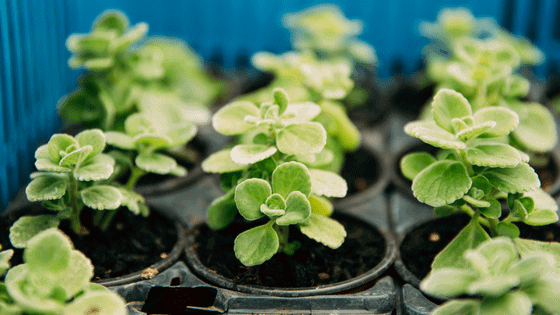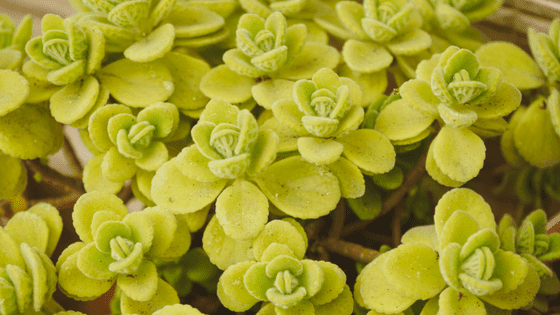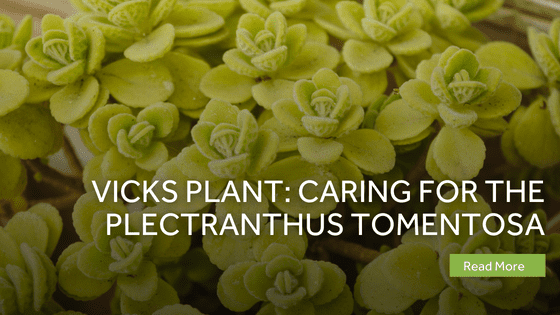If you’re looking for a plant with lavender blooms and whose aroma can make a room smell amazing, check out the Vicks plant.
Known for its menthol smell (think Vicks Vapor Rub), this beautiful succulent is a gorgeous addition to any plant collection or foliage creation.
Table of Contents
Vicks Plant Overview
It might surprise you that the Vicks plant is from warmer climates in the Southern hemisphere. It’s native to Africa, Australia, and India and doesn’t like cold temperatures.
It received its nickname – vapor rub plant – from its minty or menthol smell when you rub the leaves. The plant is typically grown for decoration, but some also use it for herbs and to clear nasal passages.
The Plectranthus tomentosa is from the Lamiaceae family and Plectranthus genus. Its botanical name is Plectranthus hadiensis var. Tomentosa, and there are around 350 species within the Plectranthus genus.
Other names the plant has besides Vicks plants are:
- Succulent coleus
- Plectranthus tomentosa
- Plectranthus zatarhendii var. tomentosus
Other plants within the Plectranthus genus include:
- Plectranthus ambiguus (Bolus) Codd
- Plectranthus antongilicus Hedge
- Plectranthus asymmetricus A.J.Paton
| Botanical Name | Plectranthus hadiensis var. tomentosa |
| Family | Lamiaceae |
| Genus | Plectranthus |
| Origin | Africa, Australia, India |
| Sunlight | Indirect |
| Watering | Weekly in the summer |
| Fertilizer | Once in the spring |
| Temperature | 65 – 85 degrees |
| Propagation | Stem cuttings |
| Potting | Terra cotta pot or hanging pots |
| Pests and Diseases | Spider mites, aphids, mealybugs, and snails |
| Toxicity | Not toxic |
Vicks Plant Features
The succulent coleus grows to about two feet tall and two and a half feet wide. It often grows as a ground cover outdoors, but it also has cascading growth if allowed to vine in hanging baskets. The plant’s shape depends on how you cut and grow it, as it’s quite versatile.
Leaves on Vicks plants grow to approximately two to three inches and have a hairy texture and light green color. The plant grows beautiful light purple flowers that grow on fragile stems. One amazing quality of this plant is its flower formation twice a year – in the early spring and early fall.
The plant doesn’t have a lot of toxic characteristics and should be safe around kids and pets, but like any plant, it’s best to keep it out of reach.
Vicks Plant Care Guide
Caring for the Vicks plant is easy, making it a great plant for beginners or anyone who wants to add a beautiful succulent plant to their home or garden.

Ideal Growing Place
Like many plants, this Lamiaceae Vicks plant doesn’t like cold temperatures, but you can grow it outdoors if you live in the right area. If you live in an area where the weather gets cold and there’s frost, make it a potted plant that you can bring indoors in the colder months.
If you grow the plant outdoors, keep it out of windy locations, as the stems are extremely fragile.
The plant grows well indoors if you want to keep it indoors year-round. Then you won’t have to worry about wind or cold damaging your plant.
Water
Succulents don’t need a lot of water because their leaves store water well. You may need to water the plant once a week in the summer or hotter months, but in the colder months, you can water much less frequently.
Only water when the soil conditions are completely dry, so when you water, soak the plant and let it drain. Don’t water again until the soil is completely dry.
Drainage is very important for this plant, so make sure the pot has plenty of drainage holes, and the plant is upright enough to have room to drain and avoid root rot.
Sunlight
Vicks plants love indirect light. They even thrive in partial shade. Outdoors, plant it near a tree or something else that can shade it and protect the plant from the wind. Indoors, keep it near a south-facing window but not directly on the window sill.
Instead, place it a few feet away from the window and ensure the window has drapes on it to filter the sun. Give the plant 4 – 6 hours of indirect sunlight, and it will thrive.
It’s important to avoid direct exposure to sunlight at all costs as it could scorch the leaves.
Temperature
Because of its origin, healthy Vicks plants like warm temperatures. Anything below 65 degrees can hurt the plant. If it gets colder in your area, plant it in a pot so you can bring it indoors in the winter or before a frost threat.
Ideally, the Vicks plant grows best at 65 – 85 degrees Fahrenheit. Plants at least one-year-old may have slightly more tolerance to colder weather because they develop woody stems, but it’s not worth the risk.
Soil
Like most healthy plants, this soft succulent likes well-draining soil. Use a quality succulent mix with peat moss for the best results. Not using well-draining soil can cause root rot, hurting your plant.
The plant does well in most soil types but avoid soils with an extremely high or low pH level.
Humidity
Growing healthy Vicks plants means keeping an eye on the humidity levels. Fortunately, it is a tolerant plant that can handle most humidity levels. However, if you have it indoors and the air feels dry, consider adding a humidifier to add excess moisture to the room. Don’t place the humidifier directly next to the plant, though. Keep it at least a few feet away.
It’s best to avoid spritzing the leaves with water which is a common way to control a plant’s moisture because it can cause fungal growth.
You May Also Like: 10 Best Plants Which Are Great For Your Garden
Fertilizer
Caring for this succulent is easy because it doesn’t require a lot of fertilizer. Light fertilization once in the early spring is enough for this plant. Choose slow-release fertilizers in liquid form and avoid over-fertilizing, as it could scorch the leaves of this attractive ornamental plant.
Pinching/Pruning
Pruning this succulent plant is important as it can grow in wild patterns if you don’t keep it under control. It’s best to remove leaves from the bottom of the plant and prune any unhealthy leaves.
If you want a fuller plant, consider pinching it to prevent flower formation. You must pinch it every few weeks to have fuller leaves and more branches.
Potting and Re-potting
Growing healthy Vicks plants works best in hanging baskets or elevated containers, and it likes to vine. No matter what pot you use, ensure it has proper drainage.
If you choose a terra cotta pot, you don’t have to worry about watering as much because terra cotta pots absorb excess moisture. However, if you plant it in any other type of pot, you must carefully determine when to water the plant.
Growth Zone
This plant grows best in zones 9b to 11b or any area without the threat of extremely cold temperatures and frost.
Common Pests, Toxins, Diseases & Other Problems
Like most plants, this plant is susceptible to various pests, including spider mites, snails, mealybugs, aphids, and whiteflies. Keep the leaves clean and remove any pests you find immediately to avoid further disease.
This plant is also susceptible to fungal and bacterial infections, which often happen with overwatering or insufficient humidity.
Propagation
Propagating the Vicks plant is easy, making it easy to give as gifts or spread your collection. It’s best done with stem cuttings in the spring or summer using these steps:
- Using sterilized scissors, cut a three to four-inch section of a stem below the leaf node
- Remove the leaves from the lower stem
- Plant the stem cuttings in a small pot or tray with potting soil and vermiculite soil
- Place the pot in indirect light
- Spray the soil every other day
Vicks Plant Mature Timeline
It takes approximately 30 days for roots to develop from your stem cuttings. After the first month, you may see leaves growing; after two months, growth gets faster, and you can replant the baby plant in a larger pot or outdoors.

Vicks Plant FAQ
How Big Does a Vicks Plant Get?
The Vicks plant only grows to approximately two feet high and two and a half feet wide. How large it gets depends on how often you pinch and prune it and the shape you help it take.
What Does Vicks Plant Smell Like?
As you might have guessed, this plant has a pungent menthol aroma. It can be pleasing to those with clogged nasal passages or feeling under the weather. The aroma can also help wake up your senses.
Is Vicks Plant a Perennial?
This plant is a tender perennial. It comes back every year, but it doesn’t withstand cold temperatures.
Is Vicks Plant a Succulent?
Yes, the Vicks plant is a succulent and is a beautiful addition to any garden or indoor plant collection.
Is Vicks Plant An Indoor Plant?
You can plant the Vicks plant indoors or out. If you keep it outdoors, bring it in if the weather drops below 65 degrees Fahrenheit.
Does Vicks Plant Repel Mosquitoes?
Mosquitos don’t like the pungent menthol aroma of the Vicks plant, so it easily repels them. To get the smell, you must rub or crush the oval leaves.
What Are Some Vicks Plant Benefits?
The Vicks plant uses are many. Benefits include acting as a decongestant by clearing clogged nasal passages or anti-inflammatory when mixed with petroleum jelly. It may also help alleviate sore muscles or minor muscle injuries.
Is Vicks Plant The Same As Cuban Oregano?
Cubano Oregano is another nickname for the Vicks plant.
How Long Do Vicks Plant Blooms Last?
The Vicks plant blooms twice a year, producing beautiful purple flowers. They last a few weeks in the spring and then bloom again in the fall.
What Kind Of Pot Is Suitable For a Vicks Plant?
For best results, pot your plant in a terra cotta pot. This makes it a lot easier to handle watering the plant because the terra cotta will absorb it if you overwater it. Other pot materials don’t do this.
Is Vicks Plant Edible?
This plant is not edible. While it’s not toxic, if it is ingested, seek medical attention to be sure you are okay.
Is Vicks Plant Rare?
The Vicks plant isn’t toxic; however, always seek medical attention if a child or pet eats it.
Vicks Vaporub Plant – The Bottom Line
The Vicks plant is an easy-to-care-for plant that works in any house or succulent garden in warmer temperatures. It flowers twice a year, or you can pinch it back to encourage more growth rather than temporary flowers.
It propagates easily, so you can share your stem cuttings with friends and neighbors and give the gift of this beautiful succulent all year long.
Last Updated on October 3, 2022 by Gustaf Johansson




